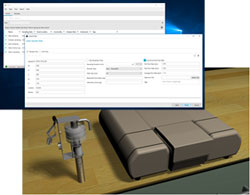NIOSH Releases Beta Version of New Respirable Crystalline Silica Monitoring Software
October 3, 2018
NIOSH Update:
Press Contact: Nura Sadeghpour (202)245-0673

Mines can now monitor worker exposure to hazardous respirable crystalline silica (RCS) more effectively thanks to new software developed by the National Institute for Occupational Safety and Health (NIOSH) Mining Program in beta version. This novel, field-based tool called “FAST” (Field Analysis of Silica Tool), works together with commercially available FTIR analyzers (Fourier Transform Infrared) to determine a worker’s exposure to RCS dust, providing detailed results immediately following a worker’s shift.
Mineworkers face the danger of potential overexposure to respirable crystalline silica dust every day. Overexposure can lead to the development of diseases such as silicosis, lung cancer, coal workers’ pneumoconiosis (CWP) (commonly known as “black lung”), and chronic obstructive pulmonary disease (COPD). These diseases are disabling, irreversible, and potentially fatal.
Key to controlling RCS at mines is the ability to quickly assess the degree of exposure. Traditional methods require mines to send samples to a commercial lab for analysis and wait for the results to be returned. Because the conditions in mines change constantly, however, immediate RCS results are needed to establish when and where high concentrations exist and to ensure that, when they do, they do not persist across shifts. The new software coupled with the FTIR analyzer allows for these immediate results.
“FAST provides a vital link for mines seeking better RCS monitoring tools by bringing the laboratory to the field,” noted NIOSH Associate Director for Mining, Dr. Jessica Kogel.
The FAST software is designed to work in concert with an easily implemented monitoring approach also developed by NIOSH, which uses portable FTIR analyzers and dust sampling cassettes at the mine site.
The combination of the FAST software, the NIOSH-developed monitoring approach, and the use of portable FTIR analyzers allows mines to quickly address the source of the exposure by eliminating the wait time between collecting a sample and receiving the lab results. Further, the monitoring approach does not degrade the dust sampling cassette, so mines can still send samples for lab testing to verify the RCS results if they wish. The results generated by FAST at the mine site can be used immediately to identify high-exposure areas and associated work tasks, which helps mines both to stay within exposure compliance limits and to proactively protect the health of their workers.
NIOSH extensively lab tested the monitoring approach that works with the FAST software, then field tested the approach in the United States and internationally, collecting dust samples in coal mines as well as samples from other types of mines. This testing led to the release of the beta version of the software to allow for further user feedback.
Respirable crystalline silica results from this initial release of FAST are accurate if a sample is collected in a coal mine. For samples collected in other types of mines, the results should be considered as approximations, since the possible presence of other minerals may decrease the accuracy of the quantification model. Future releases of FAST will offer improved accuracy for commodity types besides coal, and will also have the potential to be used beyond the mining industry.
For further information, contact mining@cdc.gov. Download a beta version of the FAST software from the NIOSH Mining website at www.cdc.gov/niosh/mining/works/coversheet2056.html
NIOSH is the federal institute that conducts research and makes recommendations for preventing work-related injuries, illnesses, and deaths. For more information about NIOSH, visit www.cdc.gov/niosh/.
